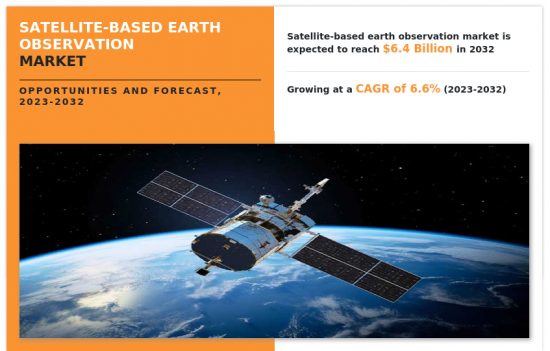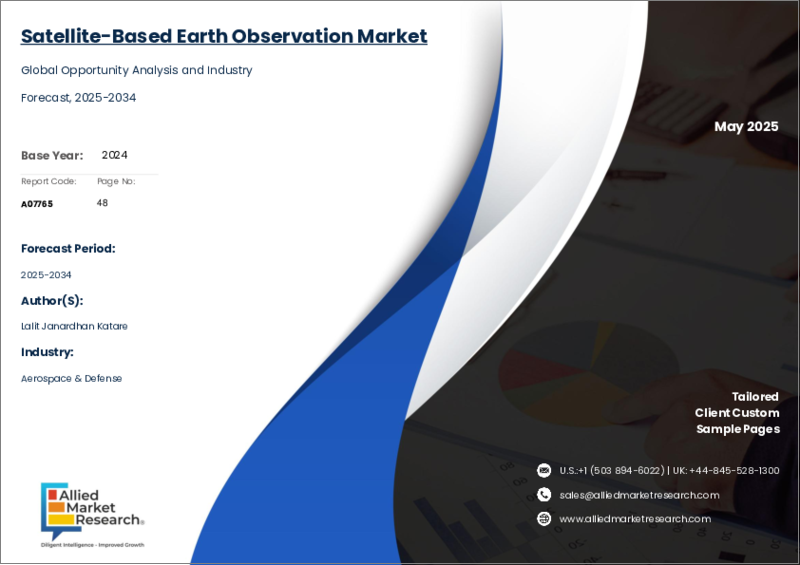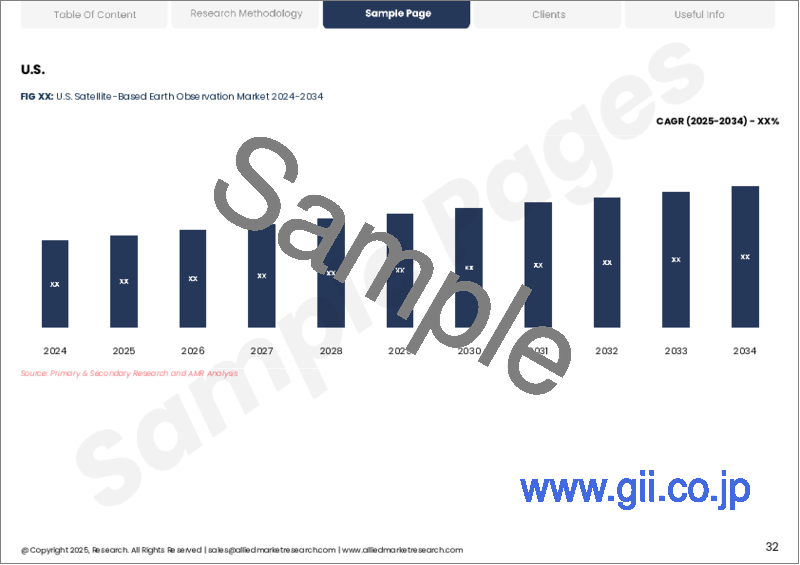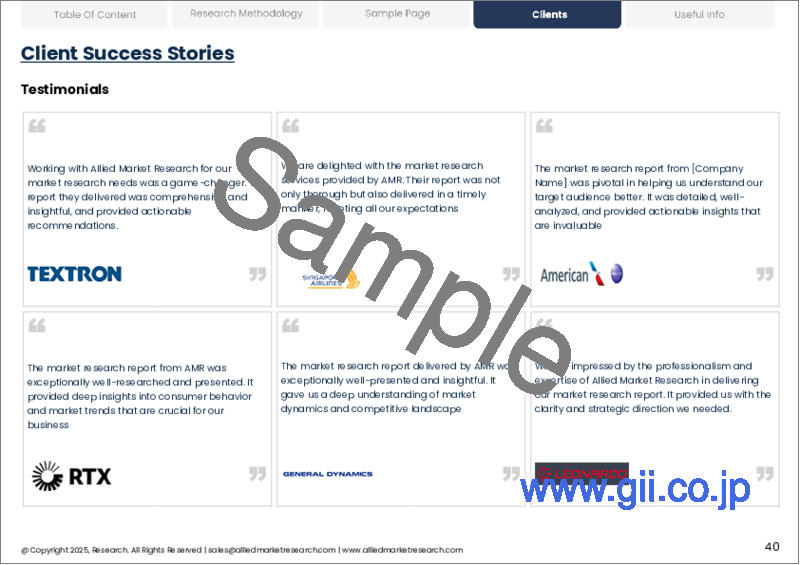|
|
市場調査レポート
商品コード
1538905
衛星ベースの地球観測市場:製品タイプ別、衛星軌道別、最終用途別:世界の機会分析と産業予測、2023-2032年Satellite-Based Earth Observation Market By Product Type, By Satellite Orbit, By End-use : Global Opportunity Analysis and Industry Forecast, 2023-2032 |
||||||
|
|||||||
| 衛星ベースの地球観測市場:製品タイプ別、衛星軌道別、最終用途別:世界の機会分析と産業予測、2023-2032年 |
|
出版日: 2024年06月01日
発行: Allied Market Research
ページ情報: 英文 391 Pages
納期: 2~3営業日
|
- 全表示
- 概要
- 目次
衛星ベースの地球観測は、衛星に搭載されたペイロードによって地球の特徴を画像データとして取得するものです。
地球観測技術は、光学センサーや熱センサー、レーダーセンサーなど、さまざまなタイプのセンサーを採用しています。光学センサーは、地表や大気による太陽エネルギーの反射と再放射によって地球から受け取るエネルギーをモニターします。光学センサーは、電磁スペクトルの可視波長と赤外線波長で動作します。レーダーセンサーは、スペクトルの低い方(波長の長い方)で作動します。地球にエネルギーを送り、地表や大気から戻ってきたエネルギーを監視するため、昼夜を問わず、あらゆる気象条件下での監視が可能になります。

センサー、撮像精度、データ処理能力の向上を含む衛星技術の進歩は、ますます精密で詳細な地球観測を容易にしています。このような技術の進歩は技術革新に拍車をかけ、さまざまな分野に有利な機会を生み出しています。さらに、衛星のペイロードを小型化し、超小型・超小型衛星の一種であるキューブサットを採用する方向への顕著なシフトが観察されています。この動向は、地球観測ミッションに適した、より小型でコスト効率の高い衛星の配備を可能にしています。このような小型衛星のコンステレーションを活用することで、再訪問の頻度が増え、地表を広くカバーできるようになります。さらに、地理空間データに対する需要の高まりは、都市計画、農業、災害対応、気候モニタリングなど、数多くの用途に及んでいます。包括的でタイムリーなデータを提供する衛星ベースの地球観測は、これらの領域で情報に基づいた意思決定を促進する上で極めて重要な役割を果たしており、市場の拡大を後押ししています。例えば、2023年10月、高度なモニタリングと分析地理空間ソリューションのプロバイダーであるSuhora Technologiesは、衛星技術企業のICEYEとの提携を発表し、ICEYEの高品質衛星画像にアクセスすることで、Suhoraのユーザーへの高度なモニタリングと分析地理空間ソリューションの提供能力を強化しました。SARデータへのアクセスは、保険、国家安全保障、災害対応、人道支援、気候変動監視など、さまざまな分野における状況認識とタイムリーな意思決定に不可欠です。より多くの産業が意思決定のための衛星ベースの地球観測データの価値を認識するにつれて、市場は今後数年で大きく成長すると予想されます。
分析のために、衛星ベースの地球観測市場スコープは、製品タイプ、衛星軌道、エンドユース、および地域に基づくセグメンテーションをカバーしています。本レポートでは、EOデータや付加価値サービスなど、衛星ベースの地球観測の様々な製品タイプに関する情報を提供しています。さらに、LEO、MEO、GEOなどの衛星軌道の詳細についても強調しています。さらに、防衛、都市開発&文化遺産、農業、気候サービス、エネルギー&原材料、インフラ、その他が、この調査でカバーされている主な最終用途です。さらに、北米、欧州、アジア太平洋、ラテンアメリカ・中東・アフリカなどの異なる地域における衛星ベースの地球観測の現在の市場動向を分析し、将来の成長機会を示唆しています。
利害関係者にとっての主な利点
- 当レポートは、2022年から2032年までの衛星ベースの地球観測市場分析の市場セグメント、現在の動向、推定、力学の定量的分析を提供し、優勢な衛星ベースの地球観測市場機会を特定します。
- 市場促進要因、市場抑制要因、市場機会に関連する情報とともに市場調査を提供します。
- ポーターのファイブフォース分析では、利害関係者が利益重視のビジネス決定を行い、サプライヤーとバイヤーのネットワークを強化できるように、バイヤーとサプライヤーの潜在力を強調します。
- 衛星ベースの地球観測市場のセグメンテーションの詳細な分析は、一般的な市場機会を決定するのに役立ちます。
- 各地域の主要国は、世界市場への収益貢献度に応じてマッピングされています。
- 市場企業のポジショニングは、ベンチマーキングを容易にし、市場企業の現在のポジションの明確な理解を提供します。
- 本レポートには、地域別および世界の衛星ベースの地球観測市場動向、主要企業、市場セグメント、応用分野、市場成長戦略の分析が含まれています。
レポートカスタマイズの可能性(別途費用とスケジュールが必要です。)
- 顧客の関心に応じた企業プロファイルの追加
- 国別または地域別の追加分析-市場規模と予測
- 企業プロファイルの拡張リスト
- SWOT分析
目次
第1章 イントロダクション
第2章 エグゼクティブサマリー
第3章 市場概要
- 市場の定義と範囲
- 主な調査結果
- 影響要因
- 主な投資機会
- ポーターのファイブフォース分析
- 市場力学
- 促進要因
- 地球観測衛星技術の進歩
- 高解像度画像サービスに対する高い需要
- EOデータから正確な洞察を得るためのビッグデータ技術に対する需要の急増
- 抑制要因
- 熟練した訓練された人材の不足
- 代替地球観測技術の利用の増加
- 機会
- 複数の政府による宇宙技術への投資の増加
- 促進要因
第4章 衛星ベースの地球観測市場、製品タイプ別
- 概要
- EOデータ
- 付加価値サービス
第5章 衛星搭載地球観測市場:衛星軌道別
- 概要
- 地球低軌道
- 中軌道
- 静止軌道
第6章 衛星利用地球観測市場:用途別
- 概要
- 防衛
- 都市開発・文化遺産
- 農業
- 気候サービス
- エネルギーと原材料
- インフラ
- その他
第7章 衛星ベース地球観測市場:地域別
- 概要
- 北米
- 米国
- カナダ
- メキシコ
- 欧州
- 英国
- ドイツ
- フランス
- ロシア
- その他
- アジア太平洋
- 中国
- 日本
- インド
- 韓国
- その他
- ラテンアメリカ
- ラテンアメリカ
- 中東
- アフリカ
第8章 競合情勢
- イントロダクション
- 主要成功戦略
- 主要10社の製品マッピング
- 競合ダッシュボード
- 競合ヒートマップ
- 主要企業のポジショニング、2022年
第9章 企業プロファイル
- Airbus SE
- Boeing
- Israel Aerospace Industries Ltd.
- Lockheed Martin Corporation
- Mitsubishi Electric Corporation
- Planet Labs PBC
- L3Harris Technologies, Inc.
- SkyWatch Space Applications Inc.
- Raytheon Technologies Corporation
- Thales Group
- Maxar Technologies
- BlackSky
- Capella Space
- ICEYE
Satellite-based earth observation relies on payloads mounted on satellites to capture imaging data of earth's characteristics. Earth observation technologies employ different types of sensors such as optical or thermal sensors, radar sensors. Optical sensors monitor the energy received from earth due to the reflection and re-emission of the sun's energy by the earth's surface or atmosphere. They operate within the visible and infrared wavelengths of the electromagnetic spectrum. Radar sensors operate in the lower part of the spectrum (longer wavelengths). They send energy to earth and monitor the energy received back from earth's surface or atmosphere, allowing for day and night monitoring in all weather conditions.

Advancements in satellite technology, encompassing enhancements in sensors, imaging precision, and data processing capabilities, facilitate increasingly precise and detailed earth observation. These technological strides spur innovation, creating lucrative opportunities across diverse sectors. Moreover, notable shift has been observed toward downsizing satellite payloads and embracing CubeSats-a class of nano- and microsatellites. This trend allows for the deployment of smaller, more cost-effective satellites tailored for earth observation missions. By leveraging constellations of these diminutive satellites, the frequency of revisits and broader coverage of the earth's surface increases, which, in turn, augments the market growth. In addition, rise in demand for geospatial data spans numerous applications such as urban planning, agriculture, disaster response, and climate monitoring. Satellite-based earth observation, offering comprehensive and timely data, plays a pivotal role in facilitating informed decision-making within these domains, thereby propelling the market expansion. For instance, in October 2023, Suhora Technologies, an advanced monitoring and analytical geospatial solutions provider, announced a partnership with ICEYE, a satellite technology company, to access ICEYE's high-quality satellite imagery, enhancing Suhora's ability to provide advanced monitoring and analytical geospatial solutions to its users. This access to SAR data is crucial for situational awareness and timely decision-making across various sectors, including insurance, national security, disaster response, humanitarian relief, and climate change monitoring. As more industries recognize the value of satellite-based earth observation data for decision-making, the market is expected to grow significantly in the coming years.
For the purpose of analysis, the satellite-based earth observation market scope covers segmentation based on product type, satellite orbit, end use, and region. The report provides information about various product types of satellite-based earth observations such as EO data and value-added services. In addition, it highlights the details about the satellite orbit, including LEO, MEO, and GEO. Furthermore, defense, urban development & cultural heritage, agriculture, climate services, energy & raw materials, infrastructure, and others are the key end uses covered in the study. Moreover, it analyzes the current market trends of satellite-based earth observations across different regions such as North America, Europe, Asia-Pacific, and LAMEA and suggests future growth opportunities.
Some major companies operating in the market include Airbus SE, Boeing, Lockheed Martin Corporation, Mitsubishi Electric Corporation, Planet Labs PBC, RAYTHEON Technologies Corporation, Israel Aerospace Industries Ltd., L3HARRIS TECHNOLOGIES, INC., Thales Group, Maxar Technologies, BlackSky, Capella Space, SkyWatch Space Applications Inc., and ICEYE.
Key Benefits For Stakeholders
- This report provides a quantitative analysis of the market segments, current trends, estimations, and dynamics of the satellite-based earth observation market analysis from 2022 to 2032 to identify the prevailing satellite-based earth observation market opportunities.
- The market research is offered along with information related to key drivers, restraints, and opportunities.
- Porter's five forces analysis highlights the potency of buyers and suppliers to enable stakeholders make profit-oriented business decisions and strengthen their supplier-buyer network.
- In-depth analysis of the satellite-based earth observation market segmentation assists to determine the prevailing market opportunities.
- Major countries in each region are mapped according to their revenue contribution to the global market.
- Market player positioning facilitates benchmarking and provides a clear understanding of the present position of the market players.
- The report includes the analysis of the regional as well as global satellite-based earth observation market trends, key players, market segments, application areas, and market growth strategies.
Additional benefits you will get with this purchase are:
- Quarterly Update and* (only available with a corporate license, on listed price)
- 5 additional Company Profile of client Choice pre- or Post-purchase, as a free update.
- Free Upcoming Version on the Purchase of Five and Enterprise User License.
- 16 analyst hours of support* (post-purchase, if you find additional data requirements upon review of the report, you may receive support amounting to 16 analyst hours to solve questions, and post-sale queries)
- 15% Free Customization* (in case the scope or segment of the report does not match your requirements, 15% is equivalent to 3 working days of free work, applicable once)
- Free data Pack on the Five and Enterprise User License. (Excel version of the report)
- Free Updated report if the report is 6-12 months old or older.
- 24-hour priority response*
- Free Industry updates and white papers.
Possible Customization with this report (with additional cost and timeline, please talk to the sales executive to know more)
- Additional company profiles with specific to client's interest
- Additional country or region analysis- market size and forecast
- Expanded list for Company Profiles
- SWOT Analysis
Key Market Segments
By Product Type
- EO Data
- Value-Added Services
By Satellite Orbit
- Low Earth Orbit
- Medium Earth Orbit
- Geostationary Orbit
By End-use
- Defense
- Urban Development and Cultural Heritage
- Agriculture
- Climate Services
- Energy and Raw Materials
- Infrastructure
- Others
By Region
- North America
- U.S.
- Canada
- Mexico
- Europe
- UK
- Germany
- France
- Russia
- Rest of Europe
- Asia-Pacific
- China
- Japan
- India
- South Korea
- Rest of Asia-Pacific
- LAMEA
- Latin America
- Middle East
- Africa
Key Market Players:
- Airbus SE
- BlackSky
- Boeing
- Capella Space
- ICEYE
- Israel Aerospace Industries Ltd.
- L3Harris Technologies, Inc.
- Lockheed Martin Corporation
- Maxar Technologies
- Mitsubishi Electric Corporation
- Planet Labs PBC
- Raytheon Technologies Corporation
- SkyWatch Space Applications Inc.
- Thales Group
TABLE OF CONTENTS
CHAPTER 1: INTRODUCTION
- 1.1. Report description
- 1.2. Key market segments
- 1.3. Key benefits to the stakeholders
- 1.4. Research methodology
- 1.4.1. Primary research
- 1.4.2. Secondary research
- 1.4.3. Analyst tools and models
CHAPTER 2: EXECUTIVE SUMMARY
- 2.1. CXO perspective
CHAPTER 3: MARKET OVERVIEW
- 3.1. Market definition and scope
- 3.2. Key findings
- 3.2.1. Top impacting factors
- 3.2.2. Top investment pockets
- 3.3. Porter's five forces analysis
- 3.3.1. Moderate to high threat of substitutes
- 3.3.2. Moderate to high intensity of rivalry
- 3.3.3. Moderate to high bargaining power of suppliers
- 3.3.4. Moderate to high threat of new entrants
- 3.3.5. Moderate to high bargaining power of buyers
- 3.4. Market dynamics
- 3.4.1. Drivers
- 3.4.1.1. Advancements in earth observation satellite technologies
- 3.4.1.2. High-demand for high-resolution imaging services
- 3.4.1.3. Surge in demand for big data technology to generate accurate insights on EO data
- 3.4.2. Restraints
- 3.4.2.1. Lack of skilled & trained personnel
- 3.4.2.2. Rise in utilization of alternative earth observation technologies
- 3.4.3. Opportunities
- 3.4.3.1. Increase in investments by several governments in space technology
- 3.4.1. Drivers
CHAPTER 4: SATELLITE-BASED EARTH OBSERVATION MARKET, BY PRODUCT TYPE
- 4.1. Overview
- 4.1.1. Market size and forecast
- 4.2. EO Data
- 4.2.1. Key market trends, growth factors and opportunities
- 4.2.2. Market size and forecast, by region
- 4.2.3. Market share analysis by country
- 4.3. Value-Added Services
- 4.3.1. Key market trends, growth factors and opportunities
- 4.3.2. Market size and forecast, by region
- 4.3.3. Market share analysis by country
CHAPTER 5: SATELLITE-BASED EARTH OBSERVATION MARKET, BY SATELLITE ORBIT
- 5.1. Overview
- 5.1.1. Market size and forecast
- 5.2. Low Earth Orbit
- 5.2.1. Key market trends, growth factors and opportunities
- 5.2.2. Market size and forecast, by region
- 5.2.3. Market share analysis by country
- 5.3. Medium Earth Orbit
- 5.3.1. Key market trends, growth factors and opportunities
- 5.3.2. Market size and forecast, by region
- 5.3.3. Market share analysis by country
- 5.4. Geostationary Orbit
- 5.4.1. Key market trends, growth factors and opportunities
- 5.4.2. Market size and forecast, by region
- 5.4.3. Market share analysis by country
CHAPTER 6: SATELLITE-BASED EARTH OBSERVATION MARKET, BY END-USE
- 6.1. Overview
- 6.1.1. Market size and forecast
- 6.2. Defense
- 6.2.1. Key market trends, growth factors and opportunities
- 6.2.2. Market size and forecast, by region
- 6.2.3. Market share analysis by country
- 6.3. Urban Development and Cultural Heritage
- 6.3.1. Key market trends, growth factors and opportunities
- 6.3.2. Market size and forecast, by region
- 6.3.3. Market share analysis by country
- 6.4. Agriculture
- 6.4.1. Key market trends, growth factors and opportunities
- 6.4.2. Market size and forecast, by region
- 6.4.3. Market share analysis by country
- 6.5. Climate Services
- 6.5.1. Key market trends, growth factors and opportunities
- 6.5.2. Market size and forecast, by region
- 6.5.3. Market share analysis by country
- 6.6. Energy and Raw Materials
- 6.6.1. Key market trends, growth factors and opportunities
- 6.6.2. Market size and forecast, by region
- 6.6.3. Market share analysis by country
- 6.7. Infrastructure
- 6.7.1. Key market trends, growth factors and opportunities
- 6.7.2. Market size and forecast, by region
- 6.7.3. Market share analysis by country
- 6.8. Others
- 6.8.1. Key market trends, growth factors and opportunities
- 6.8.2. Market size and forecast, by region
- 6.8.3. Market share analysis by country
CHAPTER 7: SATELLITE-BASED EARTH OBSERVATION MARKET, BY REGION
- 7.1. Overview
- 7.1.1. Market size and forecast By Region
- 7.2. North America
- 7.2.1. Key market trends, growth factors and opportunities
- 7.2.2. Market size and forecast, by Product Type
- 7.2.3. Market size and forecast, by Satellite Orbit
- 7.2.4. Market size and forecast, by End-use
- 7.2.5. Market size and forecast, by country
- 7.2.5.1. U.S.
- 7.2.5.1.1. Market size and forecast, by Product Type
- 7.2.5.1.2. Market size and forecast, by Satellite Orbit
- 7.2.5.1.3. Market size and forecast, by End-use
- 7.2.5.2. Canada
- 7.2.5.2.1. Market size and forecast, by Product Type
- 7.2.5.2.2. Market size and forecast, by Satellite Orbit
- 7.2.5.2.3. Market size and forecast, by End-use
- 7.2.5.3. Mexico
- 7.2.5.3.1. Market size and forecast, by Product Type
- 7.2.5.3.2. Market size and forecast, by Satellite Orbit
- 7.2.5.3.3. Market size and forecast, by End-use
- 7.3. Europe
- 7.3.1. Key market trends, growth factors and opportunities
- 7.3.2. Market size and forecast, by Product Type
- 7.3.3. Market size and forecast, by Satellite Orbit
- 7.3.4. Market size and forecast, by End-use
- 7.3.5. Market size and forecast, by country
- 7.3.5.1. UK
- 7.3.5.1.1. Market size and forecast, by Product Type
- 7.3.5.1.2. Market size and forecast, by Satellite Orbit
- 7.3.5.1.3. Market size and forecast, by End-use
- 7.3.5.2. Germany
- 7.3.5.2.1. Market size and forecast, by Product Type
- 7.3.5.2.2. Market size and forecast, by Satellite Orbit
- 7.3.5.2.3. Market size and forecast, by End-use
- 7.3.5.3. France
- 7.3.5.3.1. Market size and forecast, by Product Type
- 7.3.5.3.2. Market size and forecast, by Satellite Orbit
- 7.3.5.3.3. Market size and forecast, by End-use
- 7.3.5.4. Russia
- 7.3.5.4.1. Market size and forecast, by Product Type
- 7.3.5.4.2. Market size and forecast, by Satellite Orbit
- 7.3.5.4.3. Market size and forecast, by End-use
- 7.3.5.5. Rest of Europe
- 7.3.5.5.1. Market size and forecast, by Product Type
- 7.3.5.5.2. Market size and forecast, by Satellite Orbit
- 7.3.5.5.3. Market size and forecast, by End-use
- 7.4. Asia-Pacific
- 7.4.1. Key market trends, growth factors and opportunities
- 7.4.2. Market size and forecast, by Product Type
- 7.4.3. Market size and forecast, by Satellite Orbit
- 7.4.4. Market size and forecast, by End-use
- 7.4.5. Market size and forecast, by country
- 7.4.5.1. China
- 7.4.5.1.1. Market size and forecast, by Product Type
- 7.4.5.1.2. Market size and forecast, by Satellite Orbit
- 7.4.5.1.3. Market size and forecast, by End-use
- 7.4.5.2. Japan
- 7.4.5.2.1. Market size and forecast, by Product Type
- 7.4.5.2.2. Market size and forecast, by Satellite Orbit
- 7.4.5.2.3. Market size and forecast, by End-use
- 7.4.5.3. India
- 7.4.5.3.1. Market size and forecast, by Product Type
- 7.4.5.3.2. Market size and forecast, by Satellite Orbit
- 7.4.5.3.3. Market size and forecast, by End-use
- 7.4.5.4. South Korea
- 7.4.5.4.1. Market size and forecast, by Product Type
- 7.4.5.4.2. Market size and forecast, by Satellite Orbit
- 7.4.5.4.3. Market size and forecast, by End-use
- 7.4.5.5. Rest of Asia-Pacific
- 7.4.5.5.1. Market size and forecast, by Product Type
- 7.4.5.5.2. Market size and forecast, by Satellite Orbit
- 7.4.5.5.3. Market size and forecast, by End-use
- 7.5. LAMEA
- 7.5.1. Key market trends, growth factors and opportunities
- 7.5.2. Market size and forecast, by Product Type
- 7.5.3. Market size and forecast, by Satellite Orbit
- 7.5.4. Market size and forecast, by End-use
- 7.5.5. Market size and forecast, by country
- 7.5.5.1. Latin America
- 7.5.5.1.1. Market size and forecast, by Product Type
- 7.5.5.1.2. Market size and forecast, by Satellite Orbit
- 7.5.5.1.3. Market size and forecast, by End-use
- 7.5.5.2. Middle East
- 7.5.5.2.1. Market size and forecast, by Product Type
- 7.5.5.2.2. Market size and forecast, by Satellite Orbit
- 7.5.5.2.3. Market size and forecast, by End-use
- 7.5.5.3. Africa
- 7.5.5.3.1. Market size and forecast, by Product Type
- 7.5.5.3.2. Market size and forecast, by Satellite Orbit
- 7.5.5.3.3. Market size and forecast, by End-use
CHAPTER 8: COMPETITIVE LANDSCAPE
- 8.1. Introduction
- 8.2. Top winning strategies
- 8.3. Product mapping of top 10 player
- 8.4. Competitive dashboard
- 8.5. Competitive heatmap
- 8.6. Top player positioning, 2022
CHAPTER 9: COMPANY PROFILES
- 9.1. Airbus SE
- 9.1.1. Company overview
- 9.1.2. Key executives
- 9.1.3. Company snapshot
- 9.1.4. Operating business segments
- 9.1.5. Product portfolio
- 9.1.6. Business performance
- 9.1.7. Key strategic moves and developments
- 9.2. Boeing
- 9.2.1. Company overview
- 9.2.2. Key executives
- 9.2.3. Company snapshot
- 9.2.4. Operating business segments
- 9.2.5. Product portfolio
- 9.2.6. Business performance
- 9.3. Israel Aerospace Industries Ltd.
- 9.3.1. Company overview
- 9.3.2. Key executives
- 9.3.3. Company snapshot
- 9.3.4. Operating business segments
- 9.3.5. Product portfolio
- 9.3.6. Business performance
- 9.3.7. Key strategic moves and developments
- 9.4. Lockheed Martin Corporation
- 9.4.1. Company overview
- 9.4.2. Key executives
- 9.4.3. Company snapshot
- 9.4.4. Operating business segments
- 9.4.5. Product portfolio
- 9.4.6. Business performance
- 9.4.7. Key strategic moves and developments
- 9.5. Mitsubishi Electric Corporation
- 9.5.1. Company overview
- 9.5.2. Key executives
- 9.5.3. Company snapshot
- 9.5.4. Operating business segments
- 9.5.5. Product portfolio
- 9.5.6. Business performance
- 9.5.7. Key strategic moves and developments
- 9.6. Planet Labs PBC
- 9.6.1. Company overview
- 9.6.2. Key executives
- 9.6.3. Company snapshot
- 9.6.4. Operating business segments
- 9.6.5. Product portfolio
- 9.6.6. Business performance
- 9.6.7. Key strategic moves and developments
- 9.7. L3Harris Technologies, Inc.
- 9.7.1. Company overview
- 9.7.2. Key executives
- 9.7.3. Company snapshot
- 9.7.4. Operating business segments
- 9.7.5. Product portfolio
- 9.7.6. Business performance
- 9.7.7. Key strategic moves and developments
- 9.8. SkyWatch Space Applications Inc.
- 9.8.1. Company overview
- 9.8.2. Key executives
- 9.8.3. Company snapshot
- 9.8.4. Operating business segments
- 9.8.5. Product portfolio
- 9.8.6. Key strategic moves and developments
- 9.9. Raytheon Technologies Corporation
- 9.9.1. Company overview
- 9.9.2. Key executives
- 9.9.3. Company snapshot
- 9.9.4. Operating business segments
- 9.9.5. Product portfolio
- 9.9.6. Business performance
- 9.9.7. Key strategic moves and developments
- 9.10. Thales Group
- 9.10.1. Company overview
- 9.10.2. Key executives
- 9.10.3. Company snapshot
- 9.10.4. Operating business segments
- 9.10.5. Product portfolio
- 9.10.6. Business performance
- 9.10.7. Key strategic moves and developments
- 9.11. Maxar Technologies
- 9.11.1. Company overview
- 9.11.2. Key executives
- 9.11.3. Company snapshot
- 9.11.4. Operating business segments
- 9.11.5. Product portfolio
- 9.11.6. Business performance
- 9.11.7. Key strategic moves and developments
- 9.12. BlackSky
- 9.12.1. Company overview
- 9.12.2. Key executives
- 9.12.3. Company snapshot
- 9.12.4. Operating business segments
- 9.12.5. Product portfolio
- 9.12.6. Business performance
- 9.12.7. Key strategic moves and developments
- 9.13. Capella Space
- 9.13.1. Company overview
- 9.13.2. Key executives
- 9.13.3. Company snapshot
- 9.13.4. Operating business segments
- 9.13.5. Product portfolio
- 9.13.6. Key strategic moves and developments
- 9.14. ICEYE
- 9.14.1. Company overview
- 9.14.2. Key executives
- 9.14.3. Company snapshot
- 9.14.4. Operating business segments
- 9.14.5. Product portfolio
- 9.14.6. Key strategic moves and developments






